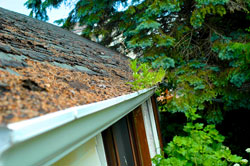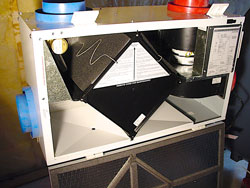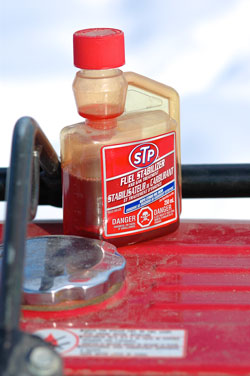I’ve often wondered how much of Canada’s national psyche is a product of the cold, cruel blasts we’re all about to endure as winter sets in. We save more money than most nations, and we’re more financially cautious. We’re also fairly comfortable banding together as a society to make good things happen. Months and months of weather that’s cold enough to kill you does have psychological implications, but it also demands practical preparations. Your home needs you right now if you expect it to endure winter elegantly. It’s time to get busy battening the hatches and embarking upon some home maintenance.
Clean Eavestroughs
Drain Outdoor Taps
Seal Driveway Cracks
Check and Replace Caulking
Furnace Inspection and Maintenance
Bleed Radiators in Hot Water Heating Systems
Chimney Cleaning and Inspection
Replace Smoke/CO Alarm Batteries and Test
Clean Eavestroughs
 Even homes without trees around them need to have eavestroughs cleaned. Wind-blown dust and surface granules eroding off asphalt shingles build up in eavestroughs over time, leading to avoidable overflows during heavy rains. Leafs only make this worse, eventually leading to rooftop plant growth and damaged eavestrough. Cleaning attachments for a garden hose, pressure washer and even a leaf blower let you clean your eavestroughs while staying safely on the ground.
Even homes without trees around them need to have eavestroughs cleaned. Wind-blown dust and surface granules eroding off asphalt shingles build up in eavestroughs over time, leading to avoidable overflows during heavy rains. Leafs only make this worse, eventually leading to rooftop plant growth and damaged eavestrough. Cleaning attachments for a garden hose, pressure washer and even a leaf blower let you clean your eavestroughs while staying safely on the ground.
Drain Outdoor Taps
Water expands with unstoppable force when it freezes, and that’s why many outdoor taps require draining. Although autumn’s first frosts aren’t cold enough to cause outdoor taps to freeze, they do serve as a warning. Drain the water now or face what could be an expensive and messy pipe repair. The process is simple: shut off water supply to the outdoor tap by closing a valve that’s on the pipe in the basement ceiling. Next, grab a small container, hold it underneath the indoor shut-off valve, then loosen the small, knurled drainage port on the side of the valve. This lets water drain back from the outdoor tap and into the container. Garden taps with a chrome or plastic dome between the handle and wall drain back each time they’re shut off, so no special attention is needed in fall.
Seal Driveway Cracks
Wet soil expands when it freezes just like water does on its own, and that’s bad news if your asphalt driveway has begun to crack. Any kind of flaw in the surface allows autumn rains to saturate the soil underneath the pavement, expanding and causing more cracks as it freezes. Take the next nice Saturday to sweep or blow all loose stuff out of driveway cracks, then seal gaps to prevent water infiltration. A little diligence now translates into many added years of driveway integrity.
Check and Replace Caulking
New homes are rarely constructed using high quality caulking. That’s because the good stuff costs hundreds of dollars more for each home, without contributing anything to boost selling prices. But just the same, caulking is vitally important for the integrity of your house. Take the time to inspect the edges of doors, windows and anything else that comes through exterior walls. Some of these areas rely on caulking, and it’s not unusual to find it in bad shape. The best recaulking jobs always begin by removing all the old stuff first, and for this you’ll need some kind of solvent. Polyurethane caulking offers the best durability, the greatest ease of use and is also paintable. I never use anything else for exterior work.
Furnace Inspection and Maintenance
 Considering their complication, modern furnaces operate with amazing reliability. That said, annual cleaning of all filters in your heating and ventilation system are required, and now is the time to book a visit from the furnace person. One thing you’ll almost certainly need to do yourself is take care of any filters in heat recovery ventilators (HRVs). These are often forgotten because they’re not directly part of the furnace, but easily cleaned. Most units hang conveniently from a basement ceiling and include clasps that hold the front closed. Open these up and you’ll find a couple of foam filters, at least one of which is probably covered in disgusting dust. You don’t want to know what this stuff is, all that matters is that you wash the filter out thoroughly, let it dry then reinstall before closing the HRV and switching it on for another season of fresher breathing.
Considering their complication, modern furnaces operate with amazing reliability. That said, annual cleaning of all filters in your heating and ventilation system are required, and now is the time to book a visit from the furnace person. One thing you’ll almost certainly need to do yourself is take care of any filters in heat recovery ventilators (HRVs). These are often forgotten because they’re not directly part of the furnace, but easily cleaned. Most units hang conveniently from a basement ceiling and include clasps that hold the front closed. Open these up and you’ll find a couple of foam filters, at least one of which is probably covered in disgusting dust. You don’t want to know what this stuff is, all that matters is that you wash the filter out thoroughly, let it dry then reinstall before closing the HRV and switching it on for another season of fresher breathing.
Bleed Radiators in Hot Water Heating Systems
Rads in hot water heating systems always accumulate unwanted air in them and this makes them noisy while also increasing your heating fuel bill. The higher the radiator is in your home, the more air it’s likely to accumulate. Starting on the upper levels of your house, working on one radiator at a time, open the bleed valve that you’ll find somewhere on each one. Hold an empty can or dish underneath the valve to catch any water that splutters out, then close the valve when all the air has bled off. You need to repeat this process three or four times each season to maximize heating efficiency.
Chimney Cleaning and Inspection
Chimney sweeps and woodstove professionals would have preferred that you call them in the spring for a cleaning, but if you haven’t there’s still time. Any chimney that handles wood-burning appliances is under much greater stress than chimneys serving gas-fired or oil burning furnaces. That’s because wood never burns as cleanly as these other fuels, and exhaust gases from wood stoves and fireplaces are much hotter.
Top-Up Tanks with Stabilized Gas
 Spring seems a long way off, but it will come again and when it does you want your lawnmower to start easily. That goes for your generator, your rototiller and any other outdoor power equipment you own. The most important thing you can do to ensure easy starting next year is to top up all gas tanks with fresh fuel that’s been treated with a gasoline stabilizer. Untreated gas goes stale, and makes starting difficult even after just a few months of storage. Gasoline stabilizer is available at most hardware stores and automotive retailers. A little goes a long way. While you’re at it, change the crankcase oil in all your seasonal four-stroke engines. Use the empty oil containers to transport used oil to a recycling centre or friendly auto garage.
Spring seems a long way off, but it will come again and when it does you want your lawnmower to start easily. That goes for your generator, your rototiller and any other outdoor power equipment you own. The most important thing you can do to ensure easy starting next year is to top up all gas tanks with fresh fuel that’s been treated with a gasoline stabilizer. Untreated gas goes stale, and makes starting difficult even after just a few months of storage. Gasoline stabilizer is available at most hardware stores and automotive retailers. A little goes a long way. While you’re at it, change the crankcase oil in all your seasonal four-stroke engines. Use the empty oil containers to transport used oil to a recycling centre or friendly auto garage.
Replace Smoke/CO Alarm Batteries and Test
This is one of those crucial yet easily forgotten chores. Besides the usual advice to change batteries every time we change clocks, use a felt tip marker to record the date of installation on every new battery you put in. This way if you can’t remember whether you changed smoke alarm batteries last time that you adjusted household clocks you can easily check. Smoke alarms are much more common in Canadian households than carbon monoxide detectors, but the CO hazard is certainly worth protecting yourself against. Don’t wait for the next tragic news story to convince you to install some, especially if your home has any kind of combustion furnace, fireplace or woodburning appliance.